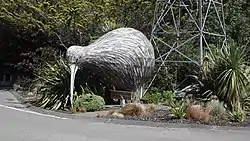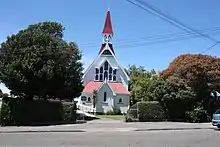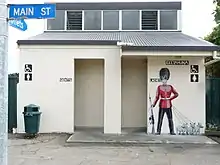Eketāhuna | |
|---|---|
 Eketāhuna Kiwi | |
| Coordinates: 40°38′49″S 175°42′14″E / 40.647°S 175.704°E | |
| Country | New Zealand |
| Region | Manawatū-Whanganui |
| Territorial authority | Tararua District |
| Ward |
|
| Community | Eketāhuna Community |
| Electorates | |
| Government | |
| • Territorial Authority | Tararua District Council |
| • Regional council | Horizons Regional Council |
| • Tararua Mayor | Tracey Collis |
| • Wairarapa MP | Mike Butterick |
| • Ikaroa-Rāwhiti MP | Cushla Tangaere-Manuel |
| Area | |
| • Total | 4.18 km2 (1.61 sq mi) |
| Population (June 2023)[2] | |
| • Total | 540 |
| • Density | 130/km2 (330/sq mi) |
| Time zone | UTC+12 (NZST) |
| • Summer (DST) | UTC+13 (NZDT) |
| Postcode | 4900 |
| Area code(s) | 06 |
Eketāhuna is a small rural settlement, in the south of the Tararua District and the Manawatū-Whanganui region of New Zealand's North Island.
The town is located at eastern foot of the Tararua Ranges, 35 kilometres north of Masterton and a similar distance south of Palmerston North. It is situated on State Highway 2, on the eastern bank of the Mākākahi River.[3]
Eketāhuna has become synonymous with stereotypes of remote rural New Zealand towns, with New Zealanders colloquially referring to the town in the same way other English speakers refer to Timbuktu.[4]
The New Zealand Ministry for Culture and Heritage gives a translation of "land on the sandbank" for Eketāhuna.[5] The name sounds like the Afrikaans sentence "I have a chicken" (Afrikaans: Ek het 'n hoender), making it amusing to immigrant Afrikaans-speaking South Africans in New Zealand.[6]
Geography
The corresponding Statistics New Zealand statistical area covers an area of 892.66 km².[7]
The Pukaha / Mount Bruce National Wildlife Centre is located to the south of the town.[6]
History

Early settlement
Eketāhuna was settled in 1872, under the name Mellemskov.[6] It was renamed soon after its founding.[8]
Modern history
The population of Eketāhuna and the wider area has plummeted in the 21st century, dropping from 1,920 in 1996 to just 630 in 2013.[9]
On 20 January 2014, the town was the epicentre of the 2014 Eketāhuna earthquake. Measuring 6.2 on the Richter magnitude scale, the quake caused moderate damage all over the southern North Island.[10]
In July 2020, the name of the town was officially gazetted as Eketāhuna by the New Zealand Geographic Board.[11]
Mayors
The Eketahuna Borough Council existed from 1907 until 1974 where it superseded by Eketahuna County Council which was later merged into Tararua District.
| Name | Term | |
|---|---|---|
| 1 | Alfred Henry Herbert | 1907-1909 |
| 2 | Edward Page | 1909-1912 |
| 3 | F.C. Turnor | 1912-1919 |
| 4 | T. Parsons | 1919-1921 |
| 5 | P. Pike | 1921-1923 |
| 6 | W. Simpson | 1923-1927 |
| 7 | T.M. Page | 1927-1929 |
| (6) | W. Simpson | 1929-1940 |
| 8 | W. Olsen | 1940-1944 |
| 9 | O. Walton | 1944-1950 |
| 10 | D.D. Ryan | 1950-1953 |
| 11 | S. Young | 1953-1959 |
| 12 | Victor Anderson | 1959-1968 |
| 13 | Graham Adam | 1968-1974 |
Demography
Eketāhuna is described by Statistics New Zealand as a rural settlement, which covers 4.18 km2 (1.61 sq mi)[1] and had an estimated population of 540 as of June 2023,[2] with a population density of 129 people per km2. It is part of the wider Nireaha-Eketahuna statistical area.
| Year | Pop. | ±% p.a. |
|---|---|---|
| 2006 | 456 | — |
| 2013 | 444 | −0.38% |
| 2018 | 504 | +2.57% |
| Source: [12] | ||
Eketāhuna had a population of 504 at the 2018 New Zealand census, an increase of 60 people (13.5%) since the 2013 census, and an increase of 48 people (10.5%) since the 2006 census. There were 222 households, comprising 255 males and 249 females, giving a sex ratio of 1.02 males per female, with 81 people (16.1%) aged under 15 years, 87 (17.3%) aged 15 to 29, 234 (46.4%) aged 30 to 64, and 102 (20.2%) aged 65 or older.
Ethnicities were 85.1% European/Pākehā, 31.5% Māori, 2.4% Pasifika, 1.8% Asian, and 1.8% other ethnicities. People may identify with more than one ethnicity.
Although some people chose not to answer the census's question about religious affiliation, 52.4% had no religion, 30.4% were Christian, 1.8% had Māori religious beliefs, 1.2% were Hindu and 3.6% had other religions.
Of those at least 15 years old, 33 (7.8%) people had a bachelor's or higher degree, and 126 (29.8%) people had no formal qualifications. 21 people (5.0%) earned over $70,000 compared to 17.2% nationally. The employment status of those at least 15 was that 156 (36.9%) people were employed full-time, 69 (16.3%) were part-time, and 36 (8.5%) were unemployed.[12]
Nireaha-Eketāhuna
Nireaha-Eketāhuna statistical area covers 892.62 km2 (344.64 sq mi)[1] and had an estimated population of 1,680 as of June 2023,[13] with a population density of 1.9 people per km2.
| Year | Pop. | ±% p.a. |
|---|---|---|
| 2006 | 1,497 | — |
| 2013 | 1,452 | −0.44% |
| 2018 | 1,566 | +1.52% |
| Source: [14] | ||
Nireaha-Eketāhuna had a population of 1,566 at the 2018 New Zealand census, an increase of 114 people (7.9%) since the 2013 census, and an increase of 69 people (4.6%) since the 2006 census. There were 597 households, comprising 816 males and 750 females, giving a sex ratio of 1.09 males per female. The median age was 37.7 years (compared with 37.4 years nationally), with 366 people (23.4%) aged under 15 years, 261 (16.7%) aged 15 to 29, 726 (46.4%) aged 30 to 64, and 207 (13.2%) aged 65 or older.
Ethnicities were 89.8% European/Pākehā, 22.6% Māori, 1.1% Pasifika, 1.7% Asian, and 1.9% other ethnicities. People may identify with more than one ethnicity.
The percentage of people born overseas was 8.8, compared with 27.1% nationally.
Although some people chose not to answer the census's question about religious affiliation, 57.7% had no religion, 28.0% were Christian, 1.5% had Māori religious beliefs, 0.4% were Hindu, 0.2% were Buddhist and 1.7% had other religions.
Of those at least 15 years old, 138 (11.5%) people had a bachelor's or higher degree, and 291 (24.2%) people had no formal qualifications. The median income was $27,600, compared with $31,800 nationally. 108 people (9.0%) earned over $70,000 compared to 17.2% nationally. The employment status of those at least 15 was that 594 (49.5%) people were employed full-time, 246 (20.5%) were part-time, and 60 (5.0%) were unemployed.[14]
Economy

In 2018, 5.0% of the workforce worked in manufacturing, 6.1% worked in construction, 5.0% worked in hospitality, 1.4% worked in transport, 3.9% worked in education, and 6.4% worked in healthcare.[9]
Transport
As of 2018, among those who commute to work, 46.4% drove a car, 3.2% rode in a car and 2.9% walked or jogged. No one commuted by public transport or cycled.[9]
Education
Eketāhuna School is a co-educational state primary school for Year 1 to 8 students,[15][16] with a roll of 97 as of April 2023.[17]
Notable people
- Ellen Anderson (1882–1978), district nurse in Eketāhuna
- Tania Lineham, born 1966 in Eketāhuna. Royal Society of New Zealand, Science and Technology Teacher Fellowship in 1999 and the Prime Minister's Science Teacher Prize in 2015.
See also
Notes
- 1 2 3 "ArcGIS Web Application". statsnz.maps.arcgis.com. Retrieved 15 May 2023.
- 1 2 "Subnational population estimates (RC, SA2), by age and sex, at 30 June 1996-2023 (2023 boundaries)". Statistics New Zealand. Retrieved 25 October 2023. (regional councils); "Subnational population estimates (TA, SA2), by age and sex, at 30 June 1996-2023 (2023 boundaries)". Statistics New Zealand. Retrieved 25 October 2023. (territorial authorities); "Subnational population estimates (urban rural), by age and sex, at 30 June 1996-2023 (2023 boundaries)". Statistics New Zealand. Retrieved 25 October 2023. (urban areas)
- ↑ "Eketahuna Travel Guide". Jasons Travel Media.
- ↑ Davison, Isaac (29 August 2017). "Heartbeat: Eketahuna makes a community-led recovery". New Zealand Media and Entertainment. The New Zealand Herald.
- ↑ "1000 Māori place names". New Zealand Ministry for Culture and Heritage. 6 August 2019.
- 1 2 3 Easther, Elisabeth (20 March 2015). "Kia ora: Eketahuna". New Zealand Media and Entertainment. The New Zealand Herald.
- ↑ "Statistical Area 2 2018 (generalised) GIS" (Data table). stats.govt.nz. Statistics New Zealand.
- ↑ "Horizons Regional Council – Regional Policy Statement". horizons.govt.nz. Horizons Regional Council.
- 1 2 3 "Place Summary – Nireaha-Eketahuna". Stats NZ. Statistics New Zealand.
- ↑ "6.2-magnitude earthquake hits lower North Island". The New Zealand Herald. 20 January 2014. Retrieved 17 June 2016.
- ↑ "Notice of approved official geographic names" (PDF). New Zealand Gazette. 16 July 2020. Retrieved 24 July 2020.
- 1 2 "Statistical area 1 dataset for 2018 Census". Statistics New Zealand. March 2020. 7018904 and 7018905.
- ↑ "Population estimate tables - NZ.Stat". Statistics New Zealand. Retrieved 25 October 2023.
- 1 2 "Statistical area 1 dataset for 2018 Census". Statistics New Zealand. March 2020. Nireaha-Eketāhuna (233700). 2018 Census place summary: Nireaha-Eketāhuna
- ↑ "Official School Website". eketahuna.school.nz.
- ↑ "Ministry of Education School Profile". educationcounts.govt.nz. Ministry of Education.
- ↑ "Education Review Office Report". ero.govt.nz. Education Review Office.
External links
- Eketahuna information at the Wayback Machine (archived 24 July 2014)